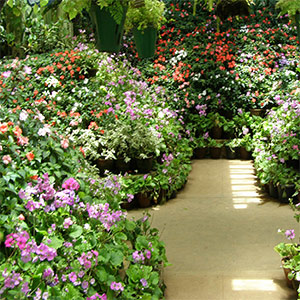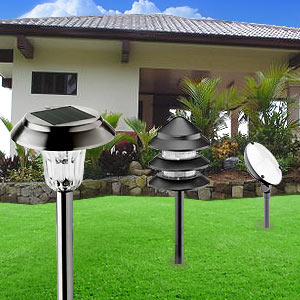Xeriscaping

Grass is interesting no doubt. But grass can be made more interesting with walkways and decks blossoming with flowers – that too from drought resistant plants which use less water. This is water-wise landscaping or Xeriscaping. There is a negative perception that this concept involves the use of barren, rocky landscapes and a few cacti. But it is not so. This is not 'zero-scape' as in the use of no water.
The term Xeriscaping is derived from Greek origin – xeros means dry and scape which means view, and therefore, landscaping sans water or landscape design with minimal use of water. Consequently, Xeriscaping is promoted in regions that are arid, with lack supplemental water for irrigation.
Xeriscaping is also variably termed as, 'drought-tolerant landscaping and 'smart scaping'. The plants used in Xeriscaping depend upon the climate. Only such plants that are appropriate to grow in the local climate are cultivated. This does not necessarily mean, selecting native plants. This is done to avoid losing water.
Why Xeriscaping?
Originally coined by a special task force of the Denver Water Department, Xeriscaping was used to describe landscaping that is done with the objective of water conservation in mind. Following a drought in 1977, low-water use plants were promoted to create a sustainable landscape in Colorado's semi arid climate. A new impetus was given to Xeriscaping in the western states in America, after a study revealed that almost 50% of water used in the households went for grass turf and landscape plantings. Xeriscaping was trademarked by Denver Water department during the late 70s and 80s.
The result – many homeowners have cut back on grass turf and instead are substituting it with 'seas of gravel and plastic'. This is their answer to water conservation. This is by no way Xeriscaping, as it beats the primary idea behind water conservation, destroys nature and produces damaging effects to trees and shrubs.
Principles of Xeriscaping
The very first principle of Xeriscaping is to draw out the basic plan. Simply draw the landscape to scale – this includes location of houses, and plants that already exist in this area. Next, write descriptive notes over the base plant. Mark out the areas that need Xeriscaping, where drought resistant plants, instead of water thirsty plants can be used. Using the bubble diagram the final landscape plant with clearly defined Xeriscaping project can be worked out.
The next principle is to create practical turf areas instead of maintaining grass lawns and keep them green. This does not necessarily mean to eradicate grass but to make use of grass wherever necessary and to enhance the landscape from other plant life and not to take away. As such there are different types of grasses and it is recommended to check with the local gardening center to see which type of grass is best suited for the landscape.
Plant selection is another cardinal principle in Xeriscaping. Plants as such define the attraction of a landscape. Consequently, the location and grouping of plants impact the amount of water used. Therefore choosing the right plants becomes pertinent and in Xeriscaping native plants are used as the best choice. Chances are outside vegetation may not adapt as quickly as local plants. In Xeriscaping plants are drought tolerant and do not require much water and local plants can be got from native gardening centers. A list of such plants can also be obtained from the University of Georgia's College of Agricultural and Environmental Sciences.
Also it is essential to determine how these plants will grow – for example plants that need more sunlight grow best on the western side of a landscape. Plants that need little water can be placed at higher elevations and those that require more can be placed lower to facilitate collection of excess water into these plants.
Soil, by and large, can be classified into three types namely – sand, silt and clay. Most of the soil is a combination of the three. Soil improvement is another essential principle in Xeriscaping. It is the right soil that can keep the plants cool, and restrain evaporating water. They can also retain excess moisture.
It is imperative to know how much water is needed for plants – even if it is just a little. Plants need regular water till they establish a root system and roots shall shrink up to look for moisture. Careful monitoring is necessary to determine how much water they need. Use a hose end sprinkler or an automatic sprinkler for watering plants efficiently.
The tip is to keep water as low to the ground as possible so that one can avoid spreading it toward unnecessary locations and causing evaporation. Drip and micro spray and bubbler systems work best especially on shrubs and flower beds.
Last but not the least, roots have to be kept cool and use of mulch does the trick. Mulch comes in two types, organic and inorganic. Wood based mulch is organic and stone based mulch is inorganic. Wood based includes bark, cedar and pine peels. Stone based includes lava and cobble stone rocks. While wood based mulch has to be replaced regularly, stones do not need replacements but they work best in shades.
Xeriscaping advantages
There is no need to use chemical supplements and fertilizers for Xeriscape plants. Healthy organic soil in itself is a sufficient healthy nutrient. These days efficient Xeriscape can raise property value. Low water consuming plants are used in Xeriscaping. Hence consumption of ground water is restricted. Hence more water becomes available for community and environment use.
- Xeriscaping requires less effort for maintenance. There are no lawns here that would require regular trimming and cutting at least.
- Xeriscaping plants take full advantage of rainfall.
- Xeriscape plants can survive water restrictions and regulations from Governments.
- Xeriscaping lawns are more interesting and visually different.
- Above all, Xeriscaping is economical and can help save a lot of money.
Xeriscaping maintenance
In Xeriscaping any foliage is slow growing and requires less water. Therefore, this makes it easier for maintenance. Typical plant grooming is enough – clear dead branches and leaves and ensure that the roots are strong.
Xeriscaping plants
Xeriscaping plants can be called 'camels' of the plant world. They evolve different strategies to survive. Plants such as stonecrop have fleshy leaves to retain water during periods of drought. This is the strategy of the Cacti plant as well. Some Xeriscape plants evolve a waxy whitish coating on the leaves. Others are leathery or finely cut to prevent water loss.
Bearded iris have fleshy rhizomes or modified stems that store water. Some plants like Stachys Byzantina, which children love for its long elephant ears, evolve hairy and wooly surfaces that conserve moisture. Lavender is another example. Wormwood and yarrow are others. However, these plants require abundant sunlight and good drainage to survive.
Prairie plants have deep tap roots – to help the plant rejuvenate even when consumed by grazing animals and to survive dry spells. Blue indigo is one such grassland species.
Purple smoke with its steel gray stems and purple flowers, Carolina Moonlight with its creamy yellow flowers are some cultivated varieties of blue indigo. Twilite Prairieblues has burgundy flowers highlighted with yellow.
In coastal plants, sea holly has deep tap root. Once planted with care, these plants stay rooted and you need not move them. Plants such as tickseed, ornamental sage and calamint are long blooming. Sea holly and butterfly weed have long lasting cut flowers.
Drought tolerant herbs are wonderfully fragrant. Butterflies and bees get attracted to the strong fragrant. Anise-hyssop is an example. Tutti Fruiti and Black Adder also emanate menthol scented foliage.
Xeriscape your yard
Xeriscape, if done properly, can create a lush, colorful and easy-to-maintain landscape. Planning, designing, limiting turf spread, selecting, zoning and maintaining plants, improving soil, Xerimulch and managing the landscape are essential to Xeriscaping.
The Denver Water's Xeriscape demonstration garden at Denver has gardens open for public viewing, through the weekdays. There is a demonstration garden available at Stapleton's Central Park.
Xeriscaping is an environmentally sustainable garden management practice. This ultimately saves time, money and energy.
Top of the Page: Xeriscaping
Tags:#Xeriscaping #Xeriscaping plants #save water on plants

Eco Friendly Homes
Garden Maintenance
Organic Gardening
Vegetable Garden Layout
Xeriscaping
Hydroponics Gardening
Feng Shui Garden
Ornamental Plant
Container Garden
Growing Succulents Indoors
Landscape Design Idea
Herb Garden Design
Window Garden
Lawn Mowing
Lawn Maintenance Tips
Orchid Care
Bonsai Tree
Cactus Plant
Thanksgiving Cactus
Rock Garden
Gardening Accessories

Bird Feeder
Leaf Blower
Solar Bird Bath
Lawn Sprinkler System
Outdoor Garden Furniture
Garden Fountain
Butterfly Garden
Electric Lawn Mower
Garden Pond
Landscaping

Landscaping
Landscape Lighting
Outdoor Canopy
Solar Garden Lights
Garage Plan
Home Improvement
Home Furnishing
Home Improvement Catalog
Feng Shui
Top of the Page: Xeriscaping
Popularity Index: 101,247

